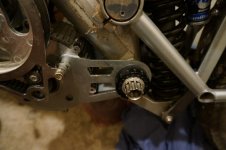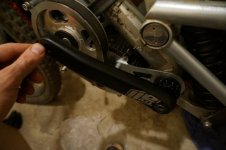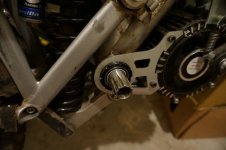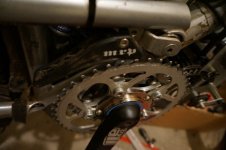You are using an out of date browser. It may not display this or other websites correctly.
You should upgrade or use an alternative browser.
You should upgrade or use an alternative browser.
Strong freewheeling crankset
- Thread starter full-throttle
- Start date
skyungjae
10 kW
looking good! 
boostjuice
10 kW
Is the ENO an intended temporary measure? If not..... I'd put higher odds on it ending-up an unintended temporary measure (without a support bearing) 
full-throttle
1 MW
Yes, temporary. Got to get the support made..
Nearly rode the bike to a BBQ 32km away with sweet single track most of the way. But it was 35deg so took the commuter instead.
Nearly rode the bike to a BBQ 32km away with sweet single track most of the way. But it was 35deg so took the commuter instead.
skyungjae
10 kW
Beautiful set up. It makes me want to order that Giga DH BB. :lol:
Well, besides the slight off true left side pedaling, things are golden. I suppose if I bend it further, it'll force my hand. Time to start freeing up some funds.
Well, besides the slight off true left side pedaling, things are golden. I suppose if I bend it further, it'll force my hand. Time to start freeing up some funds.
skyungjae
10 kW
Cyclone has an ISIS crank upgrade that may work with the GNG kit. I may pursue this route instead of the Truvativ Giga DH.
They have two ISIS upgrade kits with 140mm spindles.
They are triple chain ring kits... meaning if you still have a front derailleur, you could change between two gears up front while the third chain ring is linked to the jackshaft freewheel. I AM NOT IMPLYING THAT THIS WILL WORK WITH THE GNG and/or FIT However, it may be an option.
http://cyclone-tw.com/order-chainwheel.htm

ISIS 44T drive chain ring, 44T outer chain ring, 32T inner chain ring
98 U$D
 (it looks like they just used one picture for both :? )
(it looks like they just used one picture for both :? )
ISIS 48T drive chain ring, 48T outer chain ring, 32T inner chain ring
109 U$D
At those prices, it is cheaper than sourcing separate ISIS trials freewheel cranks & BB. I sent them an email as well as their US distributor to see if they will sell just the BB and cranks ( I don't need their chain ring set up).
Edit:
In the install pictures (of their standard triple chain ring kit w/ square taper BB), it shows them using an external lock ring on the BB for the motor mount bracket, but it doesn't appear that the ring comes with the kit. I'm assuming the tread pitch and diameter is the same that comes with the GNG BB.

They have two ISIS upgrade kits with 140mm spindles.
They are triple chain ring kits... meaning if you still have a front derailleur, you could change between two gears up front while the third chain ring is linked to the jackshaft freewheel. I AM NOT IMPLYING THAT THIS WILL WORK WITH THE GNG and/or FIT However, it may be an option.
http://cyclone-tw.com/order-chainwheel.htm

ISIS 44T drive chain ring, 44T outer chain ring, 32T inner chain ring
98 U$D

ISIS 48T drive chain ring, 48T outer chain ring, 32T inner chain ring
109 U$D
At those prices, it is cheaper than sourcing separate ISIS trials freewheel cranks & BB. I sent them an email as well as their US distributor to see if they will sell just the BB and cranks ( I don't need their chain ring set up).
Edit:
In the install pictures (of their standard triple chain ring kit w/ square taper BB), it shows them using an external lock ring on the BB for the motor mount bracket, but it doesn't appear that the ring comes with the kit. I'm assuming the tread pitch and diameter is the same that comes with the GNG BB.

Chalo
100 TW
Miles is on the right track with his support bearing coupled to the freewheel body. The only freewheel whose bearing is designed to spin with a load on it is the White Industries ENO, and its single bearing is not adequate by itself. (Conventional freewheels have two bearings, which are inadequate for other reasons.)
A White freewheel with a support bearing, or a CSK40 one-way clutch with a support bearing, would be able to withstand both full crank torque and the various bearing loads resulting from chain tension, off-angle chainline, frame flex, and impacts to the chainring.
Trying to install a splined crank on an incompatible spindle will only result in the destruction of the crank arms. Those splines have to fit just right if they are to withstand both bending loads and torque. Even then, they don't always hold up-- ask anybody who's ruined a left side square taper crank arm. My first ISIS crank fell off because the interference fit between the crank arm and spindle wasn't quite tight enough. If you just smash a non-ISIS spline onto an ISIS spindle, it won't stay tight, and it might not even get on far enough to carry the necessary torque.
The Profile crank spindles above are 3/4", which is 19.05mm. They may or may not be undersized enough to fit in a true 19mm bore, but I wouldn't count on it. They probably will accept 48 spline cranks designed for 19mm spindles, because the difference in size is within the range of the intended interference fit.
Because of the proliferation of 19mm BMX cranks, it is easy to find 19mm bearings intended for the various different bottom bracket standards: inboard, outboard, Mid, and American. Spanish BBs may be old enough news now that they are unsupported, but they use yet another size bearing that came in both 19mm and 22mm ID. Anyway, the BMX parts world is your source for inexpensive and readily available 19mm bearings, because the customary industrial sizes in that range are 17mm and 20mm.
A White freewheel with a support bearing, or a CSK40 one-way clutch with a support bearing, would be able to withstand both full crank torque and the various bearing loads resulting from chain tension, off-angle chainline, frame flex, and impacts to the chainring.
Trying to install a splined crank on an incompatible spindle will only result in the destruction of the crank arms. Those splines have to fit just right if they are to withstand both bending loads and torque. Even then, they don't always hold up-- ask anybody who's ruined a left side square taper crank arm. My first ISIS crank fell off because the interference fit between the crank arm and spindle wasn't quite tight enough. If you just smash a non-ISIS spline onto an ISIS spindle, it won't stay tight, and it might not even get on far enough to carry the necessary torque.
The Profile crank spindles above are 3/4", which is 19.05mm. They may or may not be undersized enough to fit in a true 19mm bore, but I wouldn't count on it. They probably will accept 48 spline cranks designed for 19mm spindles, because the difference in size is within the range of the intended interference fit.
Because of the proliferation of 19mm BMX cranks, it is easy to find 19mm bearings intended for the various different bottom bracket standards: inboard, outboard, Mid, and American. Spanish BBs may be old enough news now that they are unsupported, but they use yet another size bearing that came in both 19mm and 22mm ID. Anyway, the BMX parts world is your source for inexpensive and readily available 19mm bearings, because the customary industrial sizes in that range are 17mm and 20mm.
full-throttle
1 MW
You might've missed the extra support bearing mentioned in the OP. Why do you think I picked a bottom bracket with extra space on the drive side? Miles did point out the eccentricity issue.Chalo said:Miles is on the right track with his support bearing coupled to the freewheel body.
Watch and learn. Panurge has already discussed this issue. While I wouldn't recommend doing this to someone without basic metalworking skills, I'm confident what I've done will work.Chalo said:Trying to install a splined crank on an incompatible spindle will only result in the destruction of the crank arms.
Yeah sure, it was a long shot, but someone has to try it. Those who don't try fail 100% of the time.
Last night I gave the support bearing sleeve drawing to a friend with a lathe.
boostjuice
10 kW
Chalo said:The only freewheel whose bearing is designed to spin with a load on it is the White Industries ENO, and its single bearing is not adequate by itself. (Conventional freewheels have two bearings, which are inadequate for other reasons.)
Please elaborate here. I'd like to know why my long standing success in using an ACS crossfire in freewheel crank duty is so unexpected in your mind.
WI ENO sealed cartridge bearing = deep groove radial bearing, soley designed for radial loading, sealed for longer service life. 1 unit is no good for angular/axial loading. Most people reading this thread understand this.
ACS crossfire bearings = just like the vast majority of conventional economical freewheels, they feature an unsealed dual-opposed angular-contact pair characteristically able to resist loading from all angles (although primarily radial) just like non-cartridge bearing wheel hubs. Smaller bearing balls than the ENO but riding on quite smoothly forged case hardened races. Continuing to perform well in duty for me after >1000km of service with off-centre planes of chain force loaded on the freewheel placing significant angular loading. 3 pawl synchronous engagement and much tighter tolerance in lateral preload than most 'cheapie' freewheels such as dicta, shimano, ACS claws.


Chalo
100 TW
I sell lots of ACS Crossfire freewheels, and they crap out about as often as the ACS Claws freewheels I used to sell before the new model became available. They still have palpable free play in the bearings. In normal use, this is fine because they only overrun when there is no axial or radial load on them.
When you overrun them with chain tension on them (as all these no-pedal crank drive kits do), they do the same thing that a hub would do if you ran it sloppy loose-- they digest their bearings-- which are not as nice as those in a hub, either. Generic single freewheels of the traditional Shimano/Dicta/ACS Claws type tend to unscrew their adjustable cones and fall to pieces when used this way, which is why Da Vinci tandems' IPS pedal isolation device is furnished with a freewheel that has been spot welded to prevent unscrewing.
I haven't sussed out a Crossfire unit closely enough to judge whether it would be subject to the same kind of self-disassembling failure. But it certainly has not been designed to have the free play adjusted out of it, and thus it's clear that it shouldn't be spun under load as a routine practice.
I really don't understand why y'all can't just get your motor and pedal RPMs reconciled, and then simply pedal like a regular person with functional legs. It doesn't seem like a far-fetched thing to do, and then you could avoid all the crappy freewheel/ridiculous wide BB/terrible chainline nonsense that an overrunning crank brings with it.
When you overrun them with chain tension on them (as all these no-pedal crank drive kits do), they do the same thing that a hub would do if you ran it sloppy loose-- they digest their bearings-- which are not as nice as those in a hub, either. Generic single freewheels of the traditional Shimano/Dicta/ACS Claws type tend to unscrew their adjustable cones and fall to pieces when used this way, which is why Da Vinci tandems' IPS pedal isolation device is furnished with a freewheel that has been spot welded to prevent unscrewing.
I haven't sussed out a Crossfire unit closely enough to judge whether it would be subject to the same kind of self-disassembling failure. But it certainly has not been designed to have the free play adjusted out of it, and thus it's clear that it shouldn't be spun under load as a routine practice.
I really don't understand why y'all can't just get your motor and pedal RPMs reconciled, and then simply pedal like a regular person with functional legs. It doesn't seem like a far-fetched thing to do, and then you could avoid all the crappy freewheel/ridiculous wide BB/terrible chainline nonsense that an overrunning crank brings with it.
skyungjae
10 kW
I ordered the 140mm ISIS BB and ISIS freewheel cranks from cyclone. It came out to $98 shipped. I couldn't pass it up. Selling the intake on my WRX to compensate. :lol:
Hopefully the generous amount of thread locker I applied on my previous crank bolts doesn't cause me any grief.
Hopefully the generous amount of thread locker I applied on my previous crank bolts doesn't cause me any grief.
boostjuice
10 kW
Of the 3 Crossfire units I have purchased, all have had detectible but neglibable lateral freeplay. Much tighter than Shimano, Dicta and Claws units that I have also purchased and tested.Chalo said:I sell lots of ACS Crossfire freewheels, and they crap out about as often as the ACS Claws freewheels I used to sell before the new model became available. They still have palpable free play in the bearings.
Because the lateral freeplay is neglible in the 3 Crossfire units that I have recieved, there is less ability for angular misalignment to cause the flanged lip of the freewheel outer to contact the outer radius of the freewheel lockring. Therefore the amount of angular freeplay is inadequate to allow potential frictional contact to cause the lockring to unscrew. The same can't be said of other cheapy freewheels which I had ongoing lockring unscrewing problems until I started using a dab of loctite on the lockring threads which completely sorted the unscrewing problem. No need for welding.Chalo said:When you overrun them with chain tension on them (as all these no-pedal crank drive kits do), they do the same thing that a hub would do if you ran it sloppy loose-- they digest their bearings-- which are not as nice as those in a hub, either. Generic single freewheels of the traditional Shimano/Dicta/ACS Claws type tend to unscrew their adjustable cones and fall to pieces when used this way.
As for prematurely 'digesting bearings', it is true that the sloppier the tolerance - the less balls are able to share the radial/angular load. It's a sliding scale though, and again because the freeplay is tighter on the Crossfire compared with other cheapies (which are built with no concern in the bearing department except for slack chain overrunning efficiency), the Crossfire seems to hold up fine under overrunning radial/angular loads for acceptable service duty mileage, in my experience.
Not true. Of the Crossfires I have recieved, all have had a small stack of three bearing preload spacer washers clamped under the lockring. Through experimentation I discovered that if the thinnest of the three is removed, the bearing preload becomes tightened up to the point where lateral play is completely undetectable. In my case though I decided the added frictional drag of this modification was not quite worth the tradeoff as I was not having run-out and/or lockring unscrewing issues with the standard preload.Chalo said:I haven't sussed out a Crossfire unit closely enough to judge whether it would be subject to the same kind of self-disassembling failure. But it certainly has not been designed to have the free play adjusted out of it, and thus it's clear that it shouldn't be spun under load as a routine practice.
I regularly desire and appreciate riding my mid-drive e-bikes without pedal assist (particularly when I'm tired after work). Freewheel cranks are a necessity to run a simple mid-drive setup under these conditions.Chalo said:I really don't understand why y'all can't just get your motor and pedal RPMs reconciled, and then simply pedal like a regular person with functional legs. It doesn't seem like a far-fetched thing to do, and then you could avoid all the crappy freewheel/ridiculous wide BB/terrible chainline nonsense that an overrunning crank brings with it.
Chalo
100 TW
boostjuice said:I regularly desire and appreciate riding my mid-drive e-bikes without pedal assist (particularly when I'm tired after work). Freewheel cranks are a necessity to run a simple mid-drive setup under these conditions.
I suggest that a mid-drive assist ceases to be simple when it acquires an overrunning crank. That does seem to be where many of the problems and troubleshooting come into play.
A hub motor is simpler, wholly adequate for a workday commute, and does not require you to pedal. It's an elegant solution to the problem you perceive. And a normal fixed chainring crank is an elegant solution to the problems with many mid-drive kits.
full-throttle
1 MW
Why don't you read the first sentence of the first post.Chalo said:A hub motor is simpler, wholly adequate for a workday commute
#off-road
You first need to understand that there are different people with different needs to yours. Once you become comfortable with that everything else will make sense.Chalo said:I really don't understand why y'all can't just get your motor and pedal RPMs reconciled
boostjuice
10 kW
Chalo said:boostjuice said:I regularly desire and appreciate riding my mid-drive e-bikes without pedal assist (particularly when I'm tired after work). Freewheel cranks are a necessity to run a simple mid-drive setup under these conditions.
I suggest that a mid-drive assist ceases to be simple when it acquires an overrunning crank. That does seem to be where many of the problems and troubleshooting come into play.
If you can buy a higher quality kit off-the-shelf incorporating a freewheel crankset, or roll-your-own with off-the-shelf freewheel ready trials cranks, a 5 hole drilled ACS Crossfire freewheel, a ready made adaptor freewheel>spider adaptor then what's so difficult compared with butchering rear dropouts to add axle-torque brackets needed for properly done hub motor conversions.?
Chalo said:A hub motor is simpler, wholly adequate for a workday commute, and does not require you to pedal. It's an elegant solution to the problem you perceive. And a normal fixed chainring crank is an elegant solution to the problems with many mid-drive kits.
Chalo, I disagree. It's not that simple, rather entirely context specific.
I have a mid-drive rather than a hub motor on my Yuba Mundo for several reasons. Firstly for strength, durability and reliability reasons I wanted a 48 spoke rear wheel with the tensile springiness of 14G spokes rather than 36x 12/13G spokes that seems to be the required flange drilling standard for big Chinese hub motors that would be needed to push a heavy bike like this around at any reasonable performance.
As an example, 'Philistine' runs a rear 36 spoke 530X on his Yuba Mundo and has busted many spokes when carrying heavy loads of cargo/kids. A mid-drive means I don't have to worry about that weak-link.
Front hub motors are a stupid approach on most bikes (IMHO) but a complete impractability on a rear-heavy cargo bike, so that ruled them out completely in this application.
A small Cyclone/Headline mid-drive motor running at ~1350W continuous gives me ample starting torque in 1st gear with a 200kg total bike weight (myself, my GF, the bike & electric kit and groceries) and an acceptable 50kph(30mph) top speed whilst allowing a strong rear wheel (48H/14G Halo SAS/Spindoctor with 14mm 'Axeman' axle adaptors).
As for the freewheeling cranks.... Every time I ride my Yuba Mundo there are occasions where I want to hold my body/legs rigid whilst cornering or able to focus solely on my body's movement to maneuvre the bike's heavy wieght around - all whilst under power. Overrunning chainrings are a godsend necessity in allowing me to do this.
Chalo
100 TW
boostjuice said:I have a mid-drive rather than a hub motor on my Yuba Mundo for several reasons. Firstly for strength, durability and reliability reasons I wanted a 48 spoke rear wheel
That's a good call, and it's the reason I used a 48 spoke rear wheel on my hub motor equipped bike.
with the tensile springiness of 14G spokes rather than 36x 12/13G spokes that seems to be the required flange drilling standard for big Chinese hub motors that would be needed to push a heavy bike like this around at any reasonable performance.
I don't think that's a requirement at all. Quality 14ga spokes have proven much more reliable than thicker cheap spokes in every application I have seen them in. If 14ga spokes are adequate for a disc braked wheel that can stand the whole bike on its nose, why wouldn't they be adequate for a hub motor that can't even wheelie the same bike?
It is true that rear hub motors have narrow flange spacing, sometimes extreme offset, and harsh thin steel flanges that are hard on spoke elbows. These things make for weaker wheels. Not all hub motors have these design shortcomings, but most common ones do.
Front hub motors are a stupid approach on most bikes (IMHO) but a complete impractability on a rear-heavy cargo bike, so that ruled them out completely in this application.
I suggest that a front hub motor suits a longtail bike even better than it does a normal length bike, because the rider's weight is amidships and more of it is borne by the front wheel. Thus any issues with front wheel slippage are much reduced.
I used a front X5305 on my own hub motor bike, and I never found it to be anything but satisfactory. (I wasn't crazy about the heavy battery pack in the rear, but that's no fault of the motor.) I did eventually break a couple of spokes on the unmotorized rear wheel of that bike, but none of the spokes on the front hub motor. I only ever observed intermittent wheelspin when climbing very steep slopes in wet conditions, on leaf-littered brick pavement. And that was on a normal length bike with the great majority of the weight on the rear.
As for the freewheeling cranks.... Every time I ride my Yuba Mundo there are occasions where I want to hold my body/legs rigid whilst cornering or able to focus my body's movement to maneuvre the bike's heavy wieght around - all whilst under power. Overrunning chainrings are a godsend necessity in allowing me to do this.
Billions of bicyclists all over the world have suffered greatly by not being able to apply power while they coast. Good thing there are unreliable overrunning cranks that interfere with chainline and pedaling biomechanics all the rest of the time now, so you can avoid such needless torment.
full-throttle
1 MW
Alright enough of this off topic crap. Either contribute something meaningful or GTFO.
Ah, forget it. You are just too frocking dumb to understand this.
Billions of people survived without bicycles either. Yet someone did invent one. Correlation doesn't imply causation!Chalo said:boostjuice said:As for the freewheeling cranks.... Every time I ride my Yuba Mundo there are occasions where I want to hold my body/legs rigid whilst cornering or able to focus my body's movement to maneuvre the bike's heavy wieght around - all whilst under power. Overrunning chainrings are a godsend necessity in allowing me to do this.
Billions of bicyclists all over the world have suffered greatly by not being able to apply power while they coast. Good thing there are unreliable overrunning cranks that interfere with chainline and pedaling biomechanics all the rest of the time now, so you can avoid such needless torment.
Ah, forget it. You are just too frocking dumb to understand this.
http://www.bikerumor.com/2010/02/17/bottom-bracket-tech-breakdown/
Pics of the different types of external bearing cups: http://www.bikeman.com/bicycle-repair-tech-info/bikeman-tech-info/1599-bottom-bracket-types
Moving the bearings outside the shell created more room for a larger spindle inside, so external bearing bottom bracket systems can have both larger spindles and bearings than their traditional counterparts.
Spindle diameters could suddenly go up to 24mm, which made them stronger and stiffer than ever before. This was a MAJOR improvement, and created a much stiffer crankset/bottom bracket set-up, which is being widely used today. Almost every manufacturer has brought their own brand of external bearing bottom bracket systems to the market; popular models include Shimano Hollowtech II, Race Face X-type, FSA MegaEXO, and Truvativ/SRAM’s Giga X Pipe (GXP).
Pics of the different types of external bearing cups: http://www.bikeman.com/bicycle-repair-tech-info/bikeman-tech-info/1599-bottom-bracket-types
Chalo
100 TW
spinningmagnets said:http://www.bikerumor.com/2010/02/17/bottom-bracket-tech-breakdown/
Moving the bearings outside the shell created more room for a larger spindle inside, so external bearing bottom bracket systems can have both larger spindles and bearings than their traditional counterparts.
Spindle diameters could suddenly go up to 24mm, which made them stronger and stiffer than ever before. This was a MAJOR improvement, and created a much stiffer crankset/bottom bracket set-up, which is being widely used today.
This is all true. It's also true that outboard bearings turn a 68mm bottom bracket shell into something in effect like an 86mm shell, for the purposes of chainline. It's a good change overall, but it complicates a few things that were already complicated.
I know of examples of outboard BB cups for 19mm, 3/4", 22mm, 24mm, and 25mm spindles. There may be others. 24mm is the common one.
double-post removed
I know this link is from the freewheeling crank resources thread, but having it here too can help identify strong and viable options.
Thanks to wildharemtbkr for the link. http://durgendesigns.com/ddfwadapters.htm
durgendesigns.com has a $35 adapter that makes a non-freewheeling crankarm accept a FW, intended for bolting onto beefy trials cranks. I do not know the central hole ID, I assume its for a well-known beefy BB-shaft.
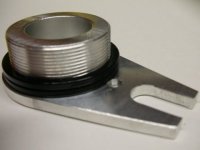
Thanks to wildharemtbkr for the link. http://durgendesigns.com/ddfwadapters.htm
durgendesigns.com has a $35 adapter that makes a non-freewheeling crankarm accept a FW, intended for bolting onto beefy trials cranks. I do not know the central hole ID, I assume its for a well-known beefy BB-shaft.

skyungjae
10 kW
spinningmagnets said:I know this link is from the freewheeling crank resources thread, but having it here too can help identify strong and viable options.
Thanks to wildharemtbkr for the link. http://durgendesigns.com/ddfwadapters.htm
durgendesigns.com has a $35 adapter that makes a non-freewheeling crankarm accept a FW, intended for bolting onto beefy trials cranks. I do not know the central hole ID, I assume its for a well-known beefy BB-shaft.
Yeah, that's pretty cool. It seems like 19mm diameter bmx spindles that accept any type of external bearing are readily available as are the cranks. Might be a better route than the ISIS option, but it may leave out room for support bearing possibilities.
Darn, wish I had more funds... I kinda just want to test all of these out. :lol:
skyungjae
10 kW
Did you get your White ENO from Sick Bike Parts?
skyungjae
10 kW
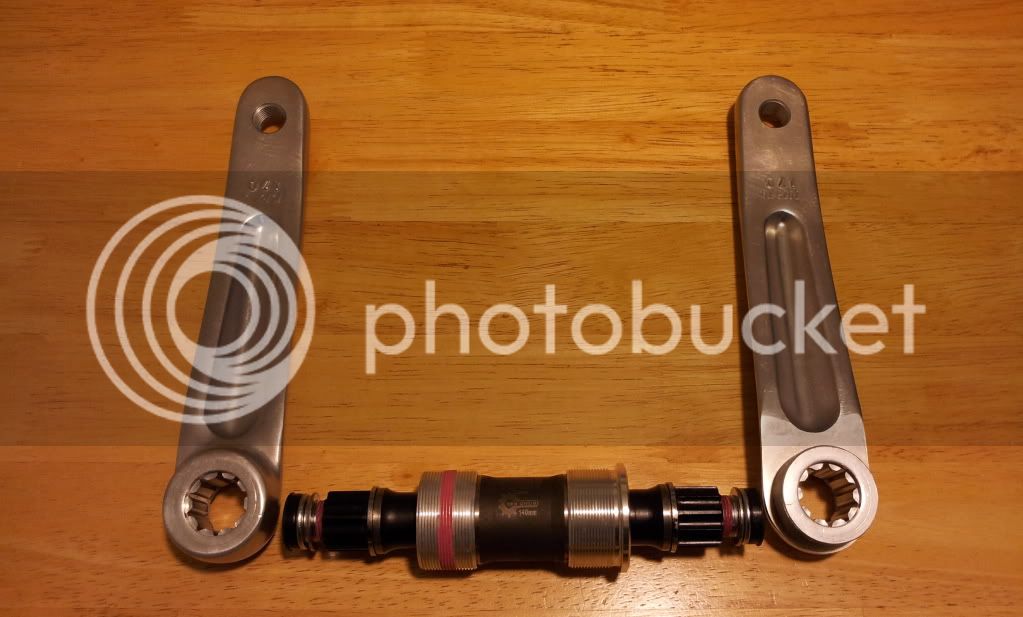

Cyclone 140mm ISIS BB and Cranks were $98 shipped to the US.
I'll try and fit everything this weekend.
Tinto
100 W
That looks great - good luck fitting it all up.
Did you get the whole set so you will be trying their freewheel too?
Edit - just looked at the prices - $98 looks like the 44T ISIS kit?
If all goes well for you I suspect cyclone will get an order from me after this weekend.
It looks like the most complete / straightforward solution to the GNG butter cranks for those of us without a lathe and other metalworking talents!
Did you get the whole set so you will be trying their freewheel too?
Edit - just looked at the prices - $98 looks like the 44T ISIS kit?
If all goes well for you I suspect cyclone will get an order from me after this weekend.
It looks like the most complete / straightforward solution to the GNG butter cranks for those of us without a lathe and other metalworking talents!
Similar threads
- Replies
- 2
- Views
- 215
- Replies
- 35
- Views
- 17,769
- Replies
- 4
- Views
- 1,944
- Replies
- 34
- Views
- 42,566
- Replies
- 11
- Views
- 5,343


